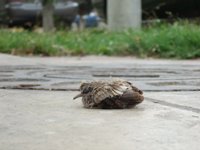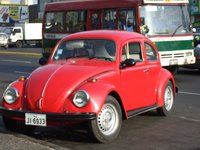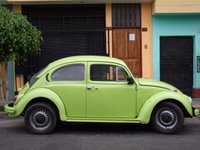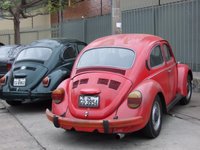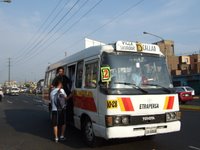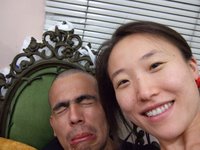
Rewind the clock three weeks back to Saturday, October 21. Carlos and I woke at 2:30 to head for the airport. He was flying to Bogotá, then Caracas; I to Panamá City, then Caracas.
I arrived in Panamá at 9:40. Immediately after deplaning, I was embraced by salty, humid air and fierce, equatorial sun. In the distance were blue skies and dense clouds anchored by low, lush mountains. Having always associated Panamá with the Canal and the Canal with modern engineering, traffic, and trade, I hardly anticipated this still, verdant vista.
My connecting flight wasn't until 19:20; I had almost ten hours to kill. So I paid for a tourist visa and signed up for a five-hour tour.
I hopped into a shiny, air-conditioned van and set off to explore Panamá City with about ten other tourists. Our guide began by describing the country's topography, the major indigenous tribes extant, and the prodigious variety of produce, including its coffee (among the best in world).
So our first stop in this fabulous, fertile land on this brief tour? Yes! A strip mall! Two hours for lunch and shopping at Conway, dollar stores, and "Indian Palaces" (as in East India) where I could find tablecloths, curtains, buttons, and much much more.

My first reaction was anger, as if someone had just picked my pockets. Then remembering my liberal education, I self-consciously wondered if I was just being a spoiled American. I began to rationalize that this was probably a more "genuine" experience; I was given a rare opportunity to "participate" in daily life as any regular Juan Schmoe would.
Based on the types of businesses I saw at the strip mall, I inferred that there was a large Chinese and Indian population present in Panamá. Likewise, American megacorporations, like McDonald’s, Burger King, and Domino’s Pizza, thrived.

After a most horrible experience at a Chinese restaurant in Lima, I decided to try my luck in Panamá and ate lunch at Mr. Chen. The ambiance at Mr. Chen exuded…pizzeria. However, I was impressed that they had pushcart dim sum service.
I ordered wanton soup and dumpling dim sum. The dishes looked better than they tasted, but wasn’t entirely disappointing.

It was amusing to watch the waiters with their pushcarts queue in a corner. Whenever a customer arrived, ushered forward by the Chinese manager, they would display their offerings and quickly retreat to their stations in the corner. Unlike in New York, where the dance of the Cantonese ladies kept a steady stream of food flowing, these young Panamanian men were as awkward as pubescent boys at their first middle-school dance.
Two hours later, we were off. Our next stop was the ruins of the original city built by the Spanish in 1519 and plundered and burned to the ground in 1671 by Welsh buccaneer (or pirate depending on your loyalties), Sir Henry Morgan. (Though, whether the blaze that destroyed the city was ignited by Morgan or the Spanish remains a matter for debate.)
Our van parked on the street and we disembarked for 5 minutes to snap pictures of the ruins. Part of the ruins were gated and marked with plaques like at a sculpture garden. Across the street were more scraps of history scattered across green fields where men played soccer and women walked their dogs.

Back in our van, we cut across town and headed 8km southwest for Casco Viejo, the city built by the Spanish after Morgan’s attack. This was a sad sight to see.

With the exception of very few houses and streets, most of Casco Viejo was decrepit, as if its citizens had cannibalized a still living man. While he was virile and had a twinkle in his eye, they sucked his fat from a cheap plastic straw, leaving his flesh and bones to rot in paradise.
This scene was made more absurd by the fact that the presidential mansion was located among this decay, separated from his neighbor—a crumbling edifice, more shell than home—by a narrow cobblestone street; the intimacy painful as a thorn pressing against raw flesh.

This time, our tour guide granted us 10 minutes to explore. I stole 5 more when I encountered these beautiful girls and took their pictures. I apologized to my tour-mates for my tardiness and we headed for the coup-de-grâce: the Panamá Canal.
For whatever reason, I expected something more akin to the Hoover Dam. I thought the Canal would be very big, with massive concrete structures and steel thingamajigs. In reality, the Canal was rather quaint—to look at anyway.
The idea of severing two continents, the engineering feat that was executed, the sheer size of the ships that use the Canal were jaw-droppingly impressive.

Some quick facts about the Canal:
- The project was begun by the French in 1890. Unequipped and unprepared for the tropical climate, they capitulated 14 years later to the mosquitoes (and disease and bankrupcy) and sold the development rights to the Americans for $25 million.
- Americans completed the project in 1914.
- About 27,500 people died from disease and accidents in the building of the Canal.
- The first ship to use the Canal was the Ancon, a steamboat.
- In 1928, Richard Halliburton took ten days to swim through the Canal and paid the lowest toll ever: $0.36.
- The most expensive toll, $249,165, was paid earlier this year by the Maersk Dellys.
- Currently, the average toll paid to cross the Canal is about $80,000 (the toll is calculated based on the weight and size of the vessel).
- About 38 vessels use the Canal each day. It takes about 8 hours to traverse the three locks of the Canal. During the day, traffic is Atlantic-bound; at night, it’s Pacific-or-bust.
- On Sunday, October 22, 2006, Panamanians voted to enlarge the Canal by adding a third lane. The project is estimated to take 7 years to complete and will cost $5 billion.

Like most of the South American countries I have visited, it seems to me that the wealth of Panamá is concentrated in the pockets of few. Despite the country's natural resources and the income generated by the Canal, extreme poverty resides alongside exceptional wealth.
In downtown Panamá, modern glass-and-steel luxury towers reach for pristine blue skies, while (literally) across the street there is a community of shacks founded and rooting deeper in contaminated mud.
From my brief visit, I have seen the beauty of the country in its breathtaking landscape and enchanting people. Yet, death and decadence dance like two dark clouds, waiting to crash and break.

 Fernando Botero is one of my favorite artists in the world, possibly of all time. My heart leaped two miles high when I learned there was an exhibit of his work in Lima, and rushed to it.
Fernando Botero is one of my favorite artists in the world, possibly of all time. My heart leaped two miles high when I learned there was an exhibit of his work in Lima, and rushed to it.

